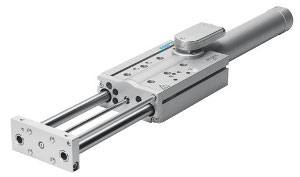
It is not possible to provide a simple answer to the question of whether a pneumatic drive is more energy-efficient than an electric drive or vice versa. "Energy efficiency in automation is dependent on the industrial application", explains Roland Volk, energy efficiency consultant at Festo. Only a direct comparison of two equally dimensioned drives - one electric and one pneumatic - is able to dispel the prejudices associated with this question.
First of all: the truth as to which drive is the most energy-efficient lies, as always, in the middle. Energy efficiency is totally dependent on the purpose for which the drive is used. Measurements reveal the following differences: for a simple motion task, an electric drive is cheaper. During press operations, the level of process force and the duration of the operation decide which technology is more efficient. However, if the application requires a holding force, pneumatics is clearly at an advantage.
In this comparison, motions are performed from point A to point B. These motions can be performed in almost all cases by pneumatic drives. Nevertheless, electric drives are commonly used to provide such simple motions. If, on the other hand, an application requires free and flexible positioning, electric drives are more advantageous.
Moving a workpiece or holding it?
These two functions result in very different energy consumption values. In the case of motion without additional process force, an electric drive consumes only one-third (25 Ws) of the energy that a pneumatic drive needs (78 Ws). For the function of pressing with process force, both drives have roughly the same energy consumption of between 20 and 30 Ws.
If, however, the drives are required to hold a certain position, the energy consumption of the electric drive shoots up to 247 Ws. This is more than 22 times as much as the energy consumption of the pneumatic drive (11 Ws). The pneumatic drive benefits from the fact that it requires energy only for the brief moment in which pressure is built up. The holding process itself can be carried out completely without any fresh compressed air supply and there are thus no energy costs. The electric drive, on the other hand, requires electricity constantly in order to remain in the desired position. The longer the holding process continues, the higher the energy consumption of the electric drive compared to the pneumatic drive. Measurements show that minor leakages have practically no influence on the low energy consumption.
Taking a close look at grippers
A comparison of electric and pneumatic grippers produces similar results. The comparison shows how finding the right solution depends on a clear definition of the application. If we consider the energy consumption during the gripping process, a pneumatic gripper is superior to an electric gripper in application with long cycles and with few gripper operations.
A pneumatic gripper requires pressure only once for continuous holding. No more pneumatic energy is then required for the duration of the holding operation. An electric gripper, which needs electrical energy for the entire duration of the holding operation, can be more energy efficient than a pneumatic gripper only if the application consists of short cycles with a large number of gripping operations.
It all depends on the application. Any industrial application has its own specific requirements regarding technical criteria such as speed, load capacity, power to weight ratio, accuracy, control behaviour, rigidity under load, efficiency and robustness, as well as economic criteria such as acquisition costs (purchase price, costs of installation and commissioning) and operating costs (maintenance, service life, energy costs).
Energy efficiency depends on the application. "This must be clearly defined before a user chooses the drive technology - electric or pneumatic or a mixture of both," explains Volk. Technologies can be compared only on the basis of the total costs of ownership (TCO), which take into account both the acquisition costs and the energy costs.





